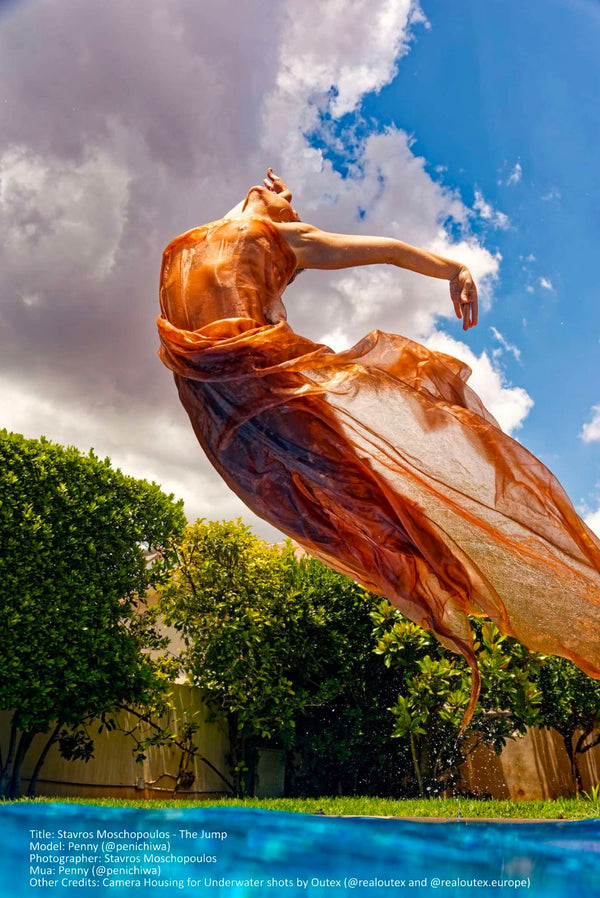Greek Pro Photographer Stavros Moschopoulos's Outex Work Recognized by Modellenland Magazine
Sep 06, 2022
1. Can you tell us a little about you?
I was born and grew up in Athens Greece when the world was full of worries about an impeding nuclear war and the Iron Curtain was still a de facto demarcation between East and West Europe. In the 70’s I moved to the USA to study computer Science and Art History. Subsequently, I worked as a Systems Analyst in Washington, DC. After 12 years in Washington, DC, I managed to make my “Tin Tin” dream come true and started working for the UN (FAO) in Rome, Italy, Bangkok, Thailand and Budapest, Hungary… 25 years roaming the world and enjoying life’s adventures… a wonderful life.

2. How and when did you get into photography?
I got into photography in the mid 80’s when my, then, wife gave me an automatic Nikon camera to take some photos on one of my trips back home to Greece… Upon my return to Washington, DC, it seems that people liked the results and asked for more photos…. So, I upgraded to a better model Nikon, signed up for courses at the Smithsonian Institution and started taking photos. Haven’t stopped ever since then.
3. What does photography mean to you?
Photography is a creative sequence of events that start from the eye and end in your soul after passing from the brain. The “Aha” moment is only understood on the soul level when all the elements of the image come together in harmony with your inner self. Thus, Photography is the art of visual and creative meditation.
4. Please briefly describe your photography style for our readers.
I cannot really define “my style”… I create images that, at times, include references to art, be it, Ancient Greek art, Caravaggio, Byzantine art or Helmut Newton and Rodney Smith. Like a delicious desert, my photos are a mix of elements that somehow make it “my style” as my customers and followers tell me. I do not limit myself to a specific style or genre. I take photos of everything that make my heart skip a beat. I could say that my style is ECLECTIC with references to my art experiences and a twist of humor.

5. Where do you get inspiration from?
From all the elements that fall under the umbrella of Art History and Contemporary photography, visits to museums, looking through magazines like Modellenland, looking at AI conceptual photographs and listening to a lot of audiobooks trying to visualize the scenes described therein. I also read the classical Greek playwrights and Greek poetry.
6. Do you think in advance what you want in the picture?
Naturally, specially for paid assignments, when a client wants a specific theme and “look”, I try to visualize how the shots should go and discuss them with the client. Once I understand the client’s needs, I add my own experience and insights and show them to the client for approval or not. For my personal work, I improvise as I go… I have a general idea of what I want the result to be and I start creating it as I go. The shooting is over when I feel that I have reached an emotional fulfillment. And then, there is a third way of creating a photo: Improvisation… I may be simply walking around or hanging out with friends and then see something that I MUST photograph… I drop everything and start shooting instinctively.
7. Studio, on location or both?
Both. I love the location shoots but only when I can control all the elements. Studio shootings lack the creative anxiety of trying to tame all the elements (weather, background, light etc) that make the shot more satisfying. In the long run, I will take a rocky seascape as a background over a blank white wall.

8. Would you consider yourself a hobbyist or a paid professional?
I am both. Nowadays everyone with a cell phone considers him/her-self a pro photographer. So the demand and pay for a pro job is very low because clients do not want to pay for your experience and art. So, I satisfy my soul by doing my work and when a paid job comes in, I give it my all. I prefer to say that I am an artist with a camera and a passionate vision.
9. What has been your most memorable session and why?
When I lived in Budapest, I was doing a project called ‘Painted Ladies’. It involved doing body paint on each of the models and then photographing them before the paint dried. In one session, I had 4 models come in, I painted one model at a time and then photographed them. It was an amazingly exhilarating experience to pour so much creativity in the space of one day. I ended up exhausted but really, really satisfied, emotionally and artistically.
10. Nikon or Canon? Favorite lens?
I use Nikons, specially for my underwater shoots. I use Outex (outex.com / @realoutex) camera housings to safeguard my equipment underwater. In the last year, I moved to OM cameras (ex Olympus). I love the freedom they offer, specially during travel. For the Nikon, I have a myriad of lenses but I use my 24-70 f/2.8 99% of the time. For the OM system, I carry and use a 12 – 45 f/4 Pro and a 45-150 f/4 Pro.

11. What is one piece of advice you would like to offer a new photographer looking to start their own business?
Make sure you have a Plan B to put some food on the table when things go to AI and there will be no more use for a photographer.
12 What do you think of our new magazine?
I first saw Modellenland a few years ago. I thought that it was the proverbial “cat’s pyjamas”. I read each issue multiple times and I store them in my digital library for reference and inspiration. Issue 108 is no exception. Excellent…

Reference Information:
Website: StavrosArtPhotos.com
Instagram: @StavrosArtPhotos2020 and @StavrosArtReview
Email: StavrosMoschopoulosPhotography@gmail.com




